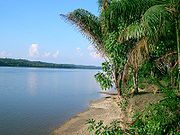
Maroni River
Encyclopedia


Sranan Tongo
Sranan is a creole language spoken as a lingua franca by approximately 300,000 people in Suriname...
: Marwina-Liba) is a river in South America. It originates in the Tumuk Humak Mountains
Tumuk Humak Mountains
The Tumuk Humak Mountains are a mountain range in South America, stretching about east-west in the border area between Brazil in the south, Suriname and French Guiana in the north. In the language of the Apalam and Wayana peoples, Tumucumaque means "the mountain rock symbolizing the struggle...
and forms the (disputed) border between French Guiana
French Guiana
French Guiana is an overseas region of France, consisting of a single overseas department located on the northern Atlantic coast of South America. It has borders with two nations, Brazil to the east and south, and Suriname to the west...
and Suriname
Suriname
Suriname , officially the Republic of Suriname , is a country in northern South America. It borders French Guiana to the east, Guyana to the west, Brazil to the south, and on the north by the Atlantic Ocean. Suriname was a former colony of the British and of the Dutch, and was previously known as...
. In its upper reaches, it is also known as the Lawa River
Lawa River (South America)
Lawa River is a river of South America. It forms part of the international boundary between Suriname and French Guiana....
, and close to its source it is known as the Marouini River.
There are two nature preserves located in the estuary region on the Surinamese side of the river, near the village of Galibi. They provide protection for the birds and the Leatherback Sea Turtle
Leatherback Sea Turtle
The leatherback sea turtle is the largest of all living sea turtles and the fourth largest modern reptile behind three crocodilians. It is the only living species in the genus Dermochelys. It can easily be differentiated from other modern sea turtles by its lack of a bony shell. Instead, its...
s that hatch there.
Border problems
In 1860, the question was posed from the French side, which of the two tributary rivers was the headwater, and thus the border. A joint French-Dutch commission was appointed to review the issue. The Dutch side of the commission consisted of J.H. Baron van Heerdt tot Eversberg, J.F.A. Cateau van Rosevelt and August Kappler. Luits Vidal, Ronmy, Boudet and Dr. Rech composed the French side. In 1861 measurements were taken, which produced the following result: the Lawa had a flow rate of 35,960 m3/minute at a width of 436 m; the Tapanahony had a flow rate of 20,291 m3/minute at a width of 285 m. Thus, the Lawa River was the headwater of the Maroni River.There were no problems with this decision until 1885. However, the discovery of gold in the area between the Lawa and the Tapanahony created a new border conflict. On 29 November 1888, France and the Netherlands
Netherlands
The Netherlands is a constituent country of the Kingdom of the Netherlands, located mainly in North-West Europe and with several islands in the Caribbean. Mainland Netherlands borders the North Sea to the north and west, Belgium to the south, and Germany to the east, and shares maritime borders...
reached an agreement that the conflict should be subject to arbitration. Czar Alexander III of Russia
Alexander III of Russia
Alexander Alexandrovich Romanov , historically remembered as Alexander III or Alexander the Peacemaker reigned as Emperor of Russia from until his death on .-Disposition:...
, acting as the arbitrator, decided that the Lawa was the headwater of the Maroni, and thus should be considered the border.
However, this decision created another issue as to which river is the source of the Lawa. The Netherlands considered the Marowini (the eastern tributary river) to be the source of the Lawa; the French considered the Litani
Litani River (South America)
The Litani or Itany is a river which forms part of the boundary between Suriname and French Guiana. It is a tributary of the Maroni River. The boundary is disputed, with Suriname also claiming land to the east of the river....
, located further to the west, to be the source of the Lawa. This issue has still not been resolved.
The Litani originates in the Tumuk Humak Mountains at approximately 2½° N 55° W; along its path it is fed by Koele Koelebreek, the Lokereek, the Mapaonikreek and the Oelemari.
The Marowini also has its source in the Tumuk Humak Mountains, at approximately 2° N, 54° W; it also absorbs the Koelebreek, among others.
Numbers
The Maroni basin is 68,700 km²; above the island ‘’Langatabbetje’’ (110 km away from the mouth of the river) this area is 63,700 km². Between 1952 and 1973, the average flow rate near ‘’Langatabbetje’’ was about 1,700 m³/second. The minimum was 95 m³/second, the maximum 6,550 m³/second. The estuary is approximately 90 km long; the average tidal range in the estuary is 2 m; in the dry season, the salt reaches about 40 km upstream to the town of AlbinaAlbina
Albina may refer to:Place* Albina, Suriname, a city in Suriname* Albina, Oregon, a city annexed by Portland, Oregon, USA* Albina, Brăila, a village in Tichileşti Commune, Brăila County, Romania...
.
The estimated potential hydro power for Suriname is between 1150 and 1250 megawatts.
Exploration
The Maroni is the most extensively studied of all the rivers in Suriname. In the 16th century, there were already ships exploring the estuary, by Lawrence Keymis, Thomas Masham, Antonio de Berrio and Adriaen Cabeliau and in the 17th century, by Harcourt, Fisher and De Vries. In the 18th century more extensive excursions took place, by Mentell, Patris, Le Blond and Heneman and in the 19th century by Zegelaar, Crevaux, Coudreau, Ten Kate, Joost and others.Of importance in the 20th century were the Gonini and Tapanahony expeditions, and the Tumuk Humak and Southern Border Expeditions. From these arose the research of the Geologisch Mijnbouwkundige Dienst (GMD) and the Centraal Bureau voor Luchtkartering (CBL).

